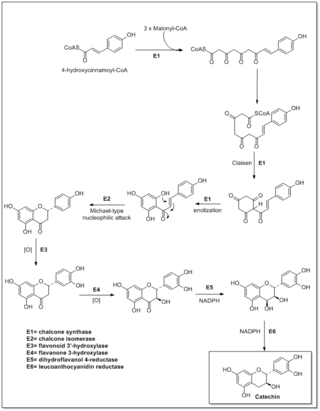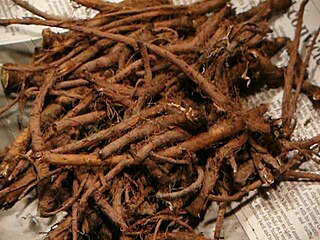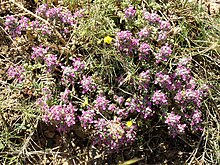
Quercitron is a yellow natural dye obtained from the bark of the Eastern Black Oak, a forest tree indigenous in North America. It was formerly called Dutch pink, English pink, or Italian pink.

Apigenin (4′,5,7-trihydroxyflavone), found in many plants, is a natural product belonging to the flavone class that is the aglycone of several naturally occurring glycosides. It is a yellow crystalline solid that has been used to dye wool.

Flavonoids are synthesized by the phenylpropanoid metabolic pathway in which the amino acid phenylalanine is used to produce 4-coumaroyl-CoA. This can be combined with malonyl-CoA to yield the true backbone of flavonoids, a group of compounds called chalcones, which contain two phenyl rings. Conjugate ring-closure of chalcones results in the familiar form of flavonoids, the three-ringed structure of a flavone. The metabolic pathway continues through a series of enzymatic modifications to yield flavanones → dihydroflavonols → anthocyanins. Along this pathway, many products can be formed, including the flavonols, flavan-3-ols, proanthocyanidins (tannins) and a host of other various polyphenolics.
In enzymology, an isoflavone-7-O-beta-glucoside 6"-O-malonyltransferase is an enzyme that catalyzes the chemical reaction
In enzymology, a flavone 7-O-beta-glucosyltransferase is an enzyme that catalyzes the chemical reaction
In enzymology, a flavone apiosyltransferase is an enzyme that catalyzes the chemical reaction

Dandelion 'coffee' is a tisane made from the root of the dandelion plant. The roasted dandelion root pieces and the beverage have some resemblance to coffee in appearance and taste, and it is thus commonly considered a coffee substitute. Dandelion root is used for both medicinal and culinary purposes and is thought to be a detoxifying herb.

Orientin is a flavone, a chemical flavonoid-like compound. It is the 8-C glucoside of luteolin.

Tricin is a chemical compound. It is an O-methylated flavone, a type of flavonoid. It can be found in rice bran and sugarcane.

Vitexin is an apigenin flavone glucoside, a chemical compound found in the passion flower, Vitex agnus-castus, in the Phyllostachys nigra bamboo leaves, in the pearl millet, and in Hawthorn.
The molecular formula C21H20O10 (molar mass: 432.38 g/mol, exact mass: 432.105647 u) may refer to:

Apiin is a natural flavonoid, a diglycoside of the flavone apigenin found in the winter-hardy plants parsley and celery, and in banana leaf. The glycoside moiety at carbon-7 of apigenin, O-β-D-apiofuranosyl(→)2-β-D-glucosyl, is carried by several other flavones in parsley plant and seed. The sugar apiose possibly play a role in winter hardiness of celery, duckweed and parsley.

Apigetrin is a chemical compound that can be found in dandelion coffee and in Teucrium gnaphalodes.

Cynaroside is a flavone, a flavonoid-like chemical compound. It is a 7-O-glucoside of luteolin.

Apiose is a branched-chain sugar found as residues in galacturonans-type pectins; that occurs in parsley and many other plants. Apiose is a component of cell wall polysaccharides.

Echinops echinatus, the Indian globe thistle, commonly known as Usnakantaka, is a species of globe thistle, found in India, Pakistan, and Sri Lanka. Indian globe thistle is an erect branched herb about 100 cm high. It has short, stout stems, branching from the base, covered with white cottony hair. Alternately arranged oblong, deeply pinnatifid leaves are 7–12 cm long. Flower heads occur in solitary white spherical balls, 3–5 cm across. Petals of the tiny white disc florets are 5 mm long. Flowers are surrounded by straight, strong, white bristles. Often misidentified with Silybum marianum (L.) Gaertner, it is colloquially known as Camel's thistle.

Luteolin-7-O-glucuronide is a chemical compound that is classified as a flavone.

Cirsilineol is a bioactive flavone isolated from Artemisia and from Teucrium gnaphalodes.

Veronicastroside is a flavone, a type of flavonoid. It is the 7-O-neohesperidoside of luteolin. It can be found in Veronicastrum sibiricum var. japonicum and in Teucrium gnaphalodes.

Phlomoides tuberosa, the sage-leaf mullein, is a perennial herbaceous flowering plant in the family Lamiaceae, native to China, Kazakhstan, Kyrgyzstan, Mongolia, Russia; SW Asia and Europe. Enlarged, tuberous roots give rise to erect stems to 150 cm bearing purple-red flowers.
















